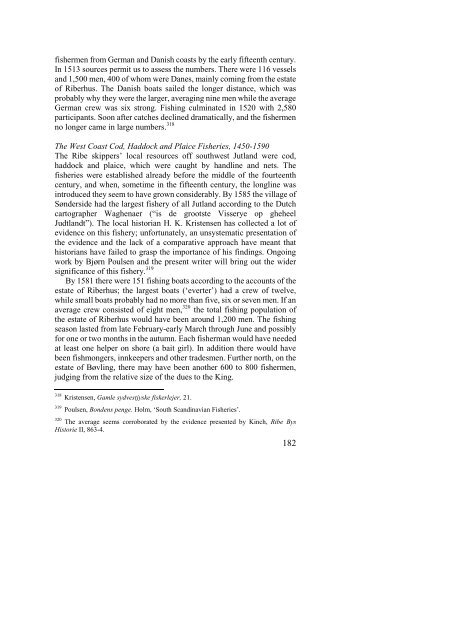The North Atlantic Fisheries, 1100-1976 - University of Hull
The North Atlantic Fisheries, 1100-1976 - University of Hull
The North Atlantic Fisheries, 1100-1976 - University of Hull
Create successful ePaper yourself
Turn your PDF publications into a flip-book with our unique Google optimized e-Paper software.
fishermen from German and Danish coasts by the early fifteenth century.<br />
In 1513 sources permit us to assess the numbers. <strong>The</strong>re were 116 vessels<br />
and 1,500 men, 400 <strong>of</strong> whom were Danes, mainly coming from the estate<br />
<strong>of</strong> Riberhus. <strong>The</strong> Danish boats sailed the longer distance, which was<br />
probably why they were the larger, averaging nine men while the average<br />
German crew was six strong. Fishing culminated in 1520 with 2,580<br />
participants. Soon after catches declined dramatically, and the fishermen<br />
no longer came in large numbers. 318<br />
<strong>The</strong> West Coast Cod, Haddock and Plaice <strong>Fisheries</strong>, 1450-1590<br />
<strong>The</strong> Ribe skippers’ local resources <strong>of</strong>f southwest Jutland were cod,<br />
haddock and plaice, which were caught by handline and nets. <strong>The</strong><br />
fisheries were established already before the middle <strong>of</strong> the fourteenth<br />
century, and when, sometime in the fifteenth century, the longline was<br />
introduced they seem to have grown considerably. By 1585 the village <strong>of</strong><br />
Sønderside had the largest fishery <strong>of</strong> all Jutland according to the Dutch<br />
cartographer Waghenaer (“is de grootste Visserye op gheheel<br />
Judtlandt”). <strong>The</strong> local historian H. K. Kristensen has collected a lot <strong>of</strong><br />
evidence on this fishery; unfortunately, an unsystematic presentation <strong>of</strong><br />
the evidence and the lack <strong>of</strong> a comparative approach have meant that<br />
historians have failed to grasp the importance <strong>of</strong> his findings. Ongoing<br />
work by Bjørn Poulsen and the present writer will bring out the wider<br />
significance <strong>of</strong> this fishery. 319<br />
By 1581 there were 151 fishing boats according to the accounts <strong>of</strong> the<br />
estate <strong>of</strong> Riberhus; the largest boats (‘everter’) had a crew <strong>of</strong> twelve,<br />
while small boats probably had no more than five, six or seven men. If an<br />
average crew consisted <strong>of</strong> eight men, 320 the total fishing population <strong>of</strong><br />
the estate <strong>of</strong> Riberhus would have been around 1,200 men. <strong>The</strong> fishing<br />
season lasted from late February-early March through June and possibly<br />
for one or two months in the autumn. Each fisherman would have needed<br />
at least one helper on shore (a bait girl). In addition there would have<br />
been fishmongers, innkeepers and other tradesmen. Further north, on the<br />
estate <strong>of</strong> Bøvling, there may have been another 600 to 800 fishermen,<br />
judging from the relative size <strong>of</strong> the dues to the King.<br />
318 Kristensen, Gamle sydvestjyske fiskerlejer, 21.<br />
319 Poulsen, Bondens penge. Holm, ‘South Scandinavian <strong>Fisheries</strong>’.<br />
320 <strong>The</strong> average seems corroborated by the evidence presented by Kinch, Ribe Bys<br />
Historie II, 863-4.<br />
182















